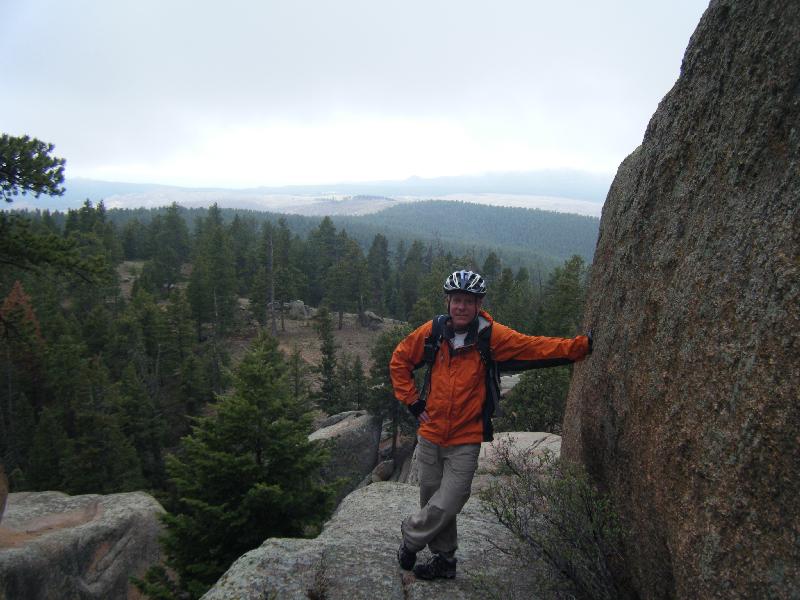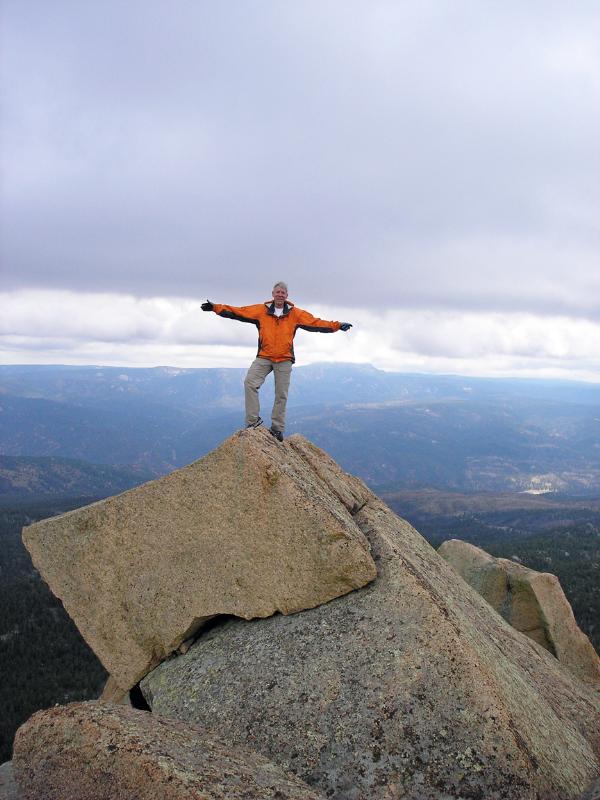We're having another run of beautiful winter days, sunny and mild. So off we went to enjoy the outdoors. We had snow and cold temps on Friday evening. We were happy to see that Saturday's weather was nice enough for outdoor fun.
We went to the Boulder area. It's lower there than it is here, so there's less snow and ice on the trail. We also wanted to do some hiking associated with certain earthcaches. An
earthcache is a non-physical cache with a geologic theme. Anyone can put one together. They are evaluated and approved by the Geological Society of America.
The prairie dogs were out today. They seemed to enjoy the sunny weather as much as we did. They were sunning themselves, running about, nibbling on weeds and seeds, barking, and so on.

The first little hike was along the Old Kiln Trail in the
Foothills Trail Area. It's a short loop that goes past an old lime kiln and along the south side of a canyon cut by Four Mile Creek. The earthcache is actually a
geology field guide, open to everyone. One claims the
earthcache by doing a bit of extra work at a few of the sites in the guide.

The Old Kiln trail wanders through several important geologic units. It's a good way to see a lot of the local geology. Similar units occur up and down the Front Range region, including near the Palmer Divide. We saw most of the units from the time of the Lykins Formation through the Niobrara Formation and Pierre Shale. Some of these units yield interesting fossils, including dinosaurs. I don't think any dinosaur fossils have been found in this area, though.
The field guide points out interesting sedimentary structures in the rocks and interprets the environment the rocks were deposited in. Many are associated with water -- swamps, ocean bottoms, shorelines, rivers. The Lyons sandstone is usually thought to be wind-driven dunes.
We did not go down-section as far as the Fountain Formation, which is associated with the erosion of an ancestral Rocky Mountain Range. The famous
Flatirons, a mountain ridge near Boulder, show off the Fountain Formation in this area. The Fountain Formation also makes up the geology of the
Red Rocks Amphitheater, and is one of the prominent rocks in the
Garden of the Gods park area. But I digress.
The photo above was taken from the Old Kiln Trail. It's a view across the road/creek to the next ridgeline to our north. We were walking through the same geologic units. This is the Dakota Hogback in this area. The Dakota Hogback is a ridge formed by tilted units in the Dakota sandstone. One finds ridges with these units paralleling the east side of the Rockies all the way through Colorado.
We were still psyched for more toddling after the first little hike, so off we went on another earthcache-related hike.
This next hike was at
Marshall Mesa Open Space. Marshall Mesa is a pleasant park that's not up against the mountains the way that the first hike was. The rocks are not tilted as much. Most of the rocks here are younger than the rocks at the first place. The oldest is the Pierre shale, and then there are a couple of younger units. One of them, the late Cretaceous Laramie Formation, often contains coal in economically attractive quantities. Marshall Mesa was the site of coal mines in the late 19th and early-mid 20th centuries, part of the Boulder-Weld coalfield. The coal wasn't fantastic stuff, but it was good enough for the local markets.

As with the first earthcache, we followed a
publicly available field guide to the geology of the park. The
earthcache version was the same, with the addition of a few extra steps.
The photo to the right is part of the view from the parking lot. One sees a valley with old mining features and a lot of prairie dogs. Above it is a low mesa with trees. There are outcrops of the different units -- sandstones, mudstones, coal -- plus evidence of faults and other things of geologic interest (such as quartzite and meta-conglomerate rocks carried here from the high mountains by old rivers). Some of the outcrops are prominent, such as the ones in the hill in this photo, while others are subtle or not well exposed. You can't see it very well in this photo, but there are ditches running through the area, too. The whole vista is very tranquil, as is the hiking experience. The trails are gentle and wide.
I've been reading about the history of coal-mining in Colorado. This area really features a lot of the things I've read about. One can see mine subsidence collapse features, evidence of underground coal fires, and so on. The non-mining geology is just as interesting. I'd babble on about it for a while, but I wouldn't want any blog readers to hurt themselves from the resulting boredom-induced coma.
Coal mining in Colorado is part of the history of the labor movement in the US. Workers were not treated well. Unionization was slow and bloody. The Open Space people have made available a nice
history of mining in the Marshall area.
---------------
Late winter is a great time for hiking at the lower elevations near here. The increasing daylength and higher sun angle actually melt some of the snow and ice. The vegetation isn't a problem. Stickery weeds from last year are knocked down, and the new growth hasn't started. Cacti are still dormant and not nearly as vicious. Rattlesnakes are still asleep. Mosquitoes and other bugs aren't really out yet. It's not too hot. The thunderstorm danger is minimal. Winter conditions can be avoided and/or planned for.
I love the quieter colors of this time of year. Without all the distracting greenery, one can see more details. There are plenty of critters that are still around, and they can be more easily seen and heard.



















































